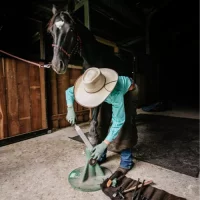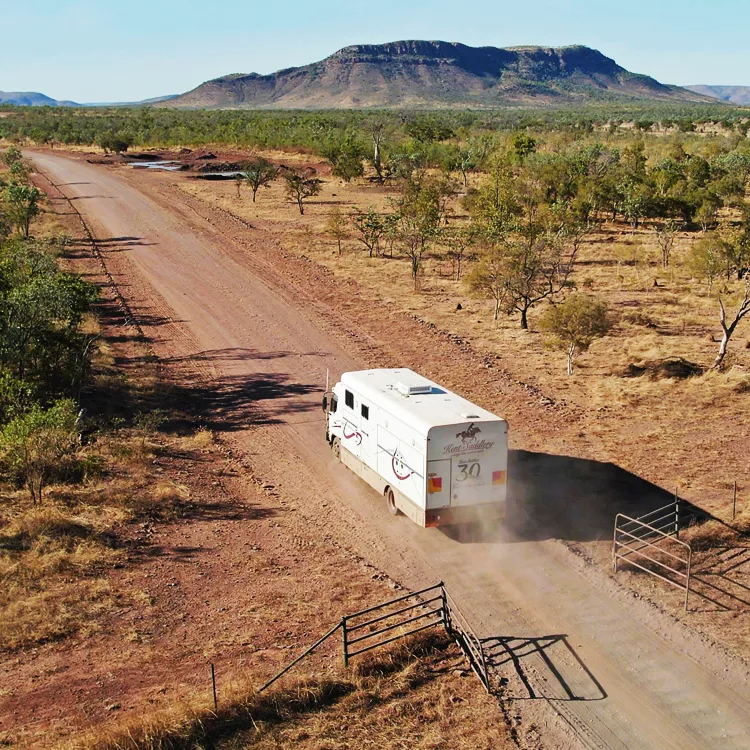Yiramalay Coacher Mustering, Ned McCord
Yiramalay Coacher Muster – Chapter 1
Coacher mustering is a technique used widely in the cattle industry across Northern Australia. lt is used to round up the cattle into one mob remembering that our cattle are spread over huge distances and wander over a large area. The aim is to mob up the cattle so that they can be educated to move as one mob. This is a handy technique when working with free range cattle – meaning cattle that have been running free and have not had a lot of education.
To start with you have a mob of quiet cattle meaning cattle that have had the opportunity of having had some education. We call this mob – coachers. This educated mob of cattle is usually made up of both sexes, different types of cattle, mixed ages and most of all a variety of personalities’ lt is important that they can work together and that there is cohesion in this mob of cattle. lt is also equally important to remember that the staff and horses you have been allocated to do the job will contribute to the success or failure of the muster. Each person has to pull their weight and be utilized to play to their strengths and if not familiar with mustering supported and mentored. Each day builds up the team. You make a team as in the outback you often do not have a choice of employees. At Leopold we have city folk, staff with a rural background, local lndigenous employees and backpackers. They all contribute in their unique way and it is important to understand them all, know their strengths and weaknesses and most of all learn how to get along and accept each other’s funny little ways. You do not have to love all of them or even like them but be able to get the best out of the staff and to work as a team.
As we move the coachers or educated cattle aroun.d the paddock strategically to cover the area that is to be mustered, the free range cattle are brought in by helicopter or by the musterers on horseback. At this point, the Coacher Mob have to open up and let the free range cattle join the mob. Once the free range cattle are part of the mob, the coachers have to accept them.for who they are and where they have come from for they too are of different ages, sexes and personalities. lf the new cattle feel welcome, safe and secure they will stay with the coacher mob, and over time will accept the confines of daily routine of the coacher mob and strive to become accepted by the coacher mob. Every now and again you will get a calf that runs away from the mob. One must learn not to chase it as it will only run further with fear. lt is better for the coacher mob to stay together and the calf will not run far and will soon realize it is safer with the mob than on its own and will return to the safety and comfort provided by the mob.
Controlling the mob of cattle as it moves through the paddock with more cattle being mustered into the mob is another key technique. This does not require someone in the lead. Rather the mob is like a small boat – you start the engine to give it power or what I call motion; then you steer it from behind left or right and speed or motion is controlled by the throttle. By having someone in the lead saying -woo! woo! Or over this way or not over there can be confusing and with the stop start motion you end up going around in circles. The mob soon feels the pressure and will start to disperse in all directions and it is not only the recently mustered free range cattle but the cattle in the coacher mob as well.
After some days of moving the cattle around the paddock you begin to relax and think that all is going well. lt is at this point sometimes the free range cattle may start to feel the pressure of daily routine and control and decide to break away. ln their mind the world has always been different and they are not used to being cared for and fed and watered on a regular basis’ This new environment can become overwhelming and the only thing they know to do is rebel and run. Life was not meant to be this good! This can be avoided by the amount of pressure that is put on the mob. Yes pressure is needed to get motion started but it also needs to be released. The individuals must feel part of the mob,but also-in control of their own destination and be able to retain their individuality. By releasing the pressure it gives them the freedom to adjust and confidence required to become part of the mob. lf they break out you need to give them time and similar to the calf they normally return after they have had time to think about how good it was with the Coacher mob. I always remind my staff when it is pressure on it also means that the pressure must come off in a controlled way.
– The coacher muster analogy is relevant to Yiramalay as it provides strategies to bring individuals together to form a community to which they want to belong. Feeling acceptance is a strong motivator to strive for individual and collective improvement. lndividuals must feel part of the mob but also be in control of their own destiny and be able to retain their individuality. I am not going to read the coacher muster story again tonight as most of you have heard it but I would like to reflect on lessons learnt and continue the analogy of moving the mob forward – I will call it chapter two.
ln summary some of the lessons learnt from the Yiramalay Coacher Muster are:
– you never have a perfect team of people. A team is built and rebuilt as every time there is a new person who enters the team the dynamics change. Everyone has something to contribute.
– setting the boundaries at the beginning is important. Everyone must understand their roles, responsibilities and most of all understand the project at hand and what it should look like.
– resources and time are needed to provide the time for students and staff to learn; everyone learns differently and some take longer than others. lt is also just as important to provide the right conditions of learning.
– pressure needs to be carefully balanced. Too much pressure can push them in the wrong direction or even push them away and too little pressure does not create cohesion and a sense of belonging.
MOVING THE MOB FORWARD.
CHAPTER 2
So now we have the mob in hand YIRRAMALAY COACHER MUSTER, MOVING THE MOB FORWARD CHAPTER TWO
The mobs of coachers are in hand with all the new free range cattle settled and accepted with a sense of belonging and moving forward. You find the stronger, more confident cattle will soon have a better understanding and strive to lead out in front. This is good, though if let go too far you can be left with two or three or if not more mobs. To maintain the one mob you need to bring the lead mob back to the rest of the mob. As leaders with in the mob they will mingle with the slower cattle and support them in what they have learnt. This will make the slower ones feel stronger and more confident so they can continue to feel they belong and move forward and be part of one mob.
It is important that the stronger cattle are pressured enough and allowed to move towards the lead again so they can be continually challenged though not too far out as you do not want to create more than one mob. lf the stronger cattle are challenged and want to be the leaders they need to also learn how to harness the potential of the individuals in the mob so as to bring them along withthem and this begins with trust. The mob has to trust them and so do the mustering team. They must learn if they are to be leaders in the mob they must first learn to walk the talk so to speak. As leaders it is essential they have a clear vision.
So to put this in a community/ team sense the lessons learnt are:-
– The stronger ones and more educated ones need to be continually challenged and used as
leaders. Let them show the way forward.
– Leaders need a clear vision.
– To move as one, all should have a goal that contributes to the overall success of the mob
and want the mob to move forward.
– Managing the changing dynamics of the mob, with pressure on and pressure off is
important.
– The motion and speed of the mob is governed by the whole mob moving forward as one.
– Everyone needs to feel they belong but it is just as important they are challenged and
motivated to learn as individuals to allow the mob to move forward.
– The mob is not there until the last one is through the gate or at home.
Most of all you can succeed best and quickest by helping others to be successful.
TO LOOK, TO LISTEN AND TO FEEL IS TO LEARN.















